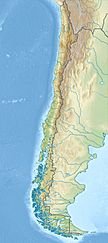Loa water frog facts for kids
Quick facts for kids Loa water frog |
|
|---|---|
| Conservation status | |
| Scientific classification |
The Telmatobius dankoi, also known as the Loa water frog, is a very special and rare type of frog. It is an critically endangered aquatic frog that lives only in Chile. This frog is found near a city called Calama, in the El Loa province.
Scientists believe there were only 14 of these frogs left in the wild in 2019. This was after their home was destroyed. Because of this, the Loa water frog might already be extinct in the wild. However, some scientists think it might be the same species as another frog, Telmatobius halli.
Contents
About the Loa Water Frog
The scientific name dankoi was chosen to honor a Chilean scientist named Danko Brncic. Before this frog was officially described in 1999, people sometimes confused it with another frog, Telmatobius halli. Scientists are still studying if the Loa water frog is truly a different species from some similar frogs, like Telmatobius vilamensis and T. halli.
What Does the Loa Water Frog Look Like?
Adult male Loa water frogs are about 4.9 to 5.5 centimeters (about 2 inches) long from their snout to their rear. Females are a bit smaller, measuring about 4.6 to 5.2 centimeters (about 1.8 to 2 inches).
These frogs have tiny thorns on their back, sides, head, and legs. They do not have an eardrum (called a tympanum) or an ear ring. Their toes are webbed, which helps them swim. Male frogs have small spines that help them hold onto females during mating.
The baby frogs, called tadpoles, can grow quite large. The longest tadpole found was about 8.5 centimeters (about 3.3 inches) long. Their body is oval-shaped and can be about 3 centimeters (about 1.2 inches) long when they are largest.
Where Do Loa Water Frogs Live?
The Loa water frog lives in small streams along the Loa River. This area is about 2,260 meters (about 7,415 feet) above sea level. The streams are in a high desert area. Plants like Baccharis glutinosa and Tessaria absinthioides grow along the edges of these streams.
What Do Loa Water Frogs Eat?
Scientists have studied what these frogs eat by looking at the contents of their stomachs. They found that Loa water frogs eat larvae of dragonflies (called odonate larvae), small snails, and tiny shrimp-like creatures called amphipods. The amphipods were the most common food they ate. Even though some types of beetles were in the same habitat, they were not found in the frogs' stomachs.
Scientists also found a type of tapeworm called Ophiotaenia calamensis living inside these frogs.
Protecting the Loa Water Frog
In 2015, a group called the International Union for Conservation of Nature (IUCN) said that the Loa water frog was critically endangered. This means it faces a very high risk of becoming extinct in the wild.
Why Are These Frogs Endangered?
The area where these frogs live is very small. Their home is being harmed by water pollution from mining activities. Other problems include people taking too much water from the streams for drinking and farming. Fun activities like recreation can also disturb their habitat.
Rescue and Conservation Efforts
In 2019, a group of conservationists and local leaders visited the place where these frogs lived. They found that the area had been badly damaged. The streams were completely dry, and the plants were withered. This was due to water being taken for mining, farming, and building new homes.
They later found a small, muddy pool nearby. In this pool, they discovered 14 Loa water frogs. These frogs were very thin and unhealthy. They were possibly the last ones left in the wild. The conservationists quickly rescued these frogs and took them to the Chilean National Zoo. The goal was to help them have babies in a safe place.
Conservationists have asked the Chilean government to protect and restore the frog's habitat. This way, the rescued frogs and their offspring can eventually be returned to the wild. In October 2020, the National Zoo announced some good news: about 200 new tadpoles were born! These tadpoles were the offspring of the frogs rescued in 2019. This gives hope for the future of the Loa water frog.
See also
 In Spanish: Telmatobius dankoi para niños
In Spanish: Telmatobius dankoi para niños



